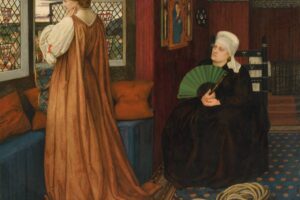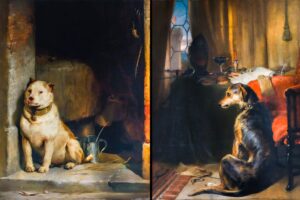Overview
A Dream of the Past: Sir Isumbras at the Ford (1857) by John Everett Millais depicts a weary knight carrying two children across a river on horseback. Clad in gleaming armor, Sir Isumbras grips one child close while another clings behind, their solemn faces reflecting both vulnerability and trust. The autumnal landscape glows with Pre-Raphaelite detail, rich with symbolism.
Millais (1829–1896), a founding member of the Pre-Raphaelite Brotherhood, was renowned for his truth to nature and emotional intensity. Inspired by medieval legend, this work marked a shift from earlier Pre-Raphaelite medievalism toward bolder, more dramatic compositions. Its meticulous textures — from the knight’s armor to the peacock feathers on the horse — exemplify the Brotherhood’s devotion to realism.
Unveiled at the Royal Academy in 1857, the painting divided critics but fascinated audiences. Today, it remains one of Millais’s most daring works, a fusion of legend, allegory, and striking naturalism.
The Story Behind the Painting
The Legend of Sir Isumbras
The subject comes from a medieval romance, where Sir Isumbras, once a proud knight, is humbled by trials of poverty and penance. In his “dream of the past,” the knight reflects on his worldly glory, symbolized by armor and warhorse, as he now bears burdens of service and care. Millais reimagines this moment with allegorical depth, portraying the knight not in triumph but in toil and endurance.
Millais’s Choice of Subject
By the mid-1850s, Millais was exploring more ambitious historical themes. The Pre-Raphaelite Brotherhood had already shocked the art world with religious and literary works; Sir Isumbras took their principles to monumental scale. The painting was also seen as a metaphor for Victorian anxieties: faith, humility, and duty amid the weight of progress.
Composition and Subjects
The Knight and Children
At the center, Sir Isumbras sits astride a massive black horse, golden armor gleaming in the fading light. One child, barefoot and cloaked in red, gazes out with haunting intensity, while the younger clings to the knight’s waist, burdened with sticks. Their presence transforms the knight into a figure of sacrifice and guardianship.
The Horse and Symbolism
The horse, adorned with gold trappings and peacock feathers, embodies both worldly pride and fading glory. Its bowed head, half-submerged in the ford, reflects the knight’s humility as he wades through difficulty. The peacock feathers, once symbols of vanity, now appear bedraggled — a visual metaphor for worldly splendor diminished.
The Setting
The landscape, painted with Pre-Raphaelite naturalism, frames the allegory. Autumn trees blaze in red and gold, a tower looms in the distance, and figures cross a bridge on the horizon. The twilight mood deepens the painting’s sense of reflection and transition.
Art Style and Techniques
Pre-Raphaelite Realism
Every surface is painted with painstaking precision: the reflections on water, the gleam of armor, and the intricate vegetation at the riverbank. Millais’s eye for detail exemplifies the Pre-Raphaelite credo of “truth to nature.”
Monumental Composition
At over 10 feet wide, the painting is massive, designed to overwhelm viewers. Its bold arrangement — horse, knight, and children filling the foreground — created a sense of immediacy unusual for the time.
Symbolic Allegory
Beyond its realism, the painting is layered with meaning. The contrast of splendor and humility, past glory and present burden, reflects both medieval morality and Victorian self-examination.
Legacy and Reflection
Critical Reception
When exhibited in 1857, the painting drew mixed reviews. Some critics admired its daring scale and allegory; others mocked its perceived awkwardness. Yet its dramatic vision ensured lasting attention, and it became one of Millais’s most discussed works.
Enduring Significance
Today, Sir Isumbras at the Ford is recognized as a milestone in Millais’s career. It marks the evolution of the Pre-Raphaelite style from intimate detail to monumental storytelling, and it embodies themes of humility, endurance, and the passage of time.
An armored knight carries children across a river, autumn leaves glowing behind him, feathers bedraggled, armor shining. In A Dream of the Past: Sir Isumbras at the Ford, Millais transforms legend into allegory, creating a painting both medieval in story and deeply Victorian in meaning.



